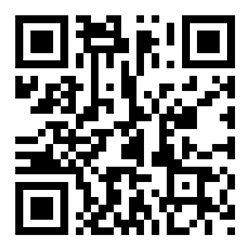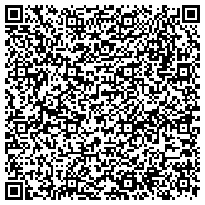What are QR codes?
A QR code (originally short for Quick Response code) is a machine-readable barcode that can be scanned and interpreted by dedicated scanners, or – more importantly to us – nearly any mobile device with a camera. Users of IOS11 or higher and some Android users will find they have native support for QR codes in their phone or tablet; users of older hardware can choose from many different QR apps compatible with their device (most of them free of charge).
What do they look like?
QR codes typically appear as a square two-dimensional matrix of other squares in one-bit colour (I.e., squares are only either black or white). Early standards had as few as 21 x 21 squares (441 in total) but later versions can feature as many as 177 x 177 squares (just under 32K squares!). Unsurprisingly, more squares mean the potential for more encoded data. QR codes can also feature logos or other artwork, at a cost to the amount of data they can hold. The simple, typically black-and-white format of QR codes makes them trivially easy to add to any printed or digitally displayed material.
What can they hold?
The data encoded into a QR code can include numeric, alphanumeric, binary values, or Kanji. The largest QR codes can encode an impressive 4,296 characters. For comparison, this post in its entirety contains only 3558 characters.
In commercial applications, QR codes can hold tracking information, part/product numbers, ticket or invoice information, or any other alphanumeric information, or any other alphanumeric data that must be read and used quickly and accurately. In more consumer-oriented contexts, QR codes can store personal information, payment and banking information, login credentials, or – perhaps the most familiar use of QR codes – website or multimedia URIs/URLs. In practice, QR codes don’t hold all the information you would like a user to see, but rather a pointer to that information (which can then be as extensive or enriched as you wish).
Why should we be interested?
QR codes represent a uniquely mobile technology. While a desktop computer outfitted with a camera could certainly read and interpret a QR code, there would be little utility in printing or gathering QR codes and holding them up to the webcam! In practice, QR codes are found in our external environments – on billboards, packaging, business cards, brochures, print ads, or even “lost dog” posters. Reading and interpreting these “on the go” is a natural fit for mobile technologies.
It’s true that a “lost dog” poster could also simply display an e-mail address or a website in familiar and human-readable letters and numbers, but pointing a gadget at a QR code is considerably more convenient, more accurate, and quicker than manually entering information with the other alternative (“two thumb” typing). In the case of encoded website addresses, many devices will immediately direct the user to that website using their default browser.
I’m sold! Where can I get one?
If you would like to read QR codes, check the application store compatible with your device.
If you wish to generate QR codes with your own information, there are many sites or applications to choose from, but for most purposes you may find QRCode Monkey sufficient. It’s free to use, and the QR codes you generate can be downloaded in a variety of formats for printing on posters, business cards, flyers, or ETEC523 posts!
I’ve generated a few QR codes shown below. I invite you to point your gadget and find out what they are!





Hi Sean,
As someone living in China for the past 8 years, I have seen the rise and expansion of QR codes to almost an unimaginable level. QR codes have become an essential part of life here in China. They are essentially used for literally everything, from identifying pets, giving and receiving money, shared transportation, identification, advertising, fundraising…, and the list goes on. QR codes played a major role in curbing the spread of COVID-19 in China. QR codes linked to health passports formed a sort of digital wall, and China has been able to track and trace extremely efficiently. They have also played a major role in tracking student health as students returned to school this year.
An old Chinese proverb suggests: “Tell me and I’ll forget. Show me, and I may remember. Involve me, and I’ll understand” QR codes are how to involve students directly into education. By scanning QR codes, students can find books, tutor groups can be formed, student progress tracked, information can be shared and received and learning outside the classroom can be facilitated.
QR codes have proven to be extremely successful in China and throughout Asia. I always questioned why western countries were so slow to implement such technology. With the pandemic, it is my belief that we will see QR codes become much more popular in all aspects of life in North America.
Here you can read about how a QR code in the sky above Shanghai by 1500 drones to promote a video game.
https://www.vice.com/en/article/88n9vb/shanghai-drone-show-qr-code
The article asks some important questions we often come across with the heavy use of technology, such as privacy rights and mass consumerism.
Thanks for this quick overview of QR codes. I have seen them around for several years, but haven’t given them too much thought. They are posted around our campus to identify several of the trees, but for some reason in my mind it was an old technology that was going to fade away with our CD’s and memory sticks. It wasn’t until this past year when I started noticing them at almost every restaurant that I realized how useful they can be. They are a quick and simple method to access information. Maybe I should start trying to learn about the trees…
Funny that you’d talk about them as deprecated technology — a day or two ago I read an article on defunct tech that suggested QR codes are a dying fad, but the primary reason the author gave for this opinion is that they aren’t really used all that much in the United States, at least not in a social context. I see them all over the place here in Toronto, from big signs to flyers stapled to poles. There’s currently one outside of the grocery store I frequent, as part of their active Covid screening — if you want to skip the paper questionnaire you can point your phone at the code, complete an electronic questionnaire one time, then just show it at every subsequent visit.
Hi Sean!
Thanks for sharing this!
I like the use of QR codes. We use them for adding audio to the books at our school, so students can take the books home, and if necessary, scan the QR code to read them as audio books. In Asia, many people add QR codes onto their name cards to link to the company website, so instead of reading the website link, people can just scan to access the company website directly on their mobile device.
Hi Emily. That pretty much sums up the utility of them, doesn’t it? If you want users to make the jump from printed material (sign, book, poster, flyer, business card) to electronic material (a webpage, a video, multimedia) as easily as possible, they’re great.
Thank you, Sean for your post about QR codes. I have seen them on posters, product packages or websites, but I had not thought about using them in classroom until I watched this video (https://youtu.be/tt05MjNSHKA?t=681). It provides some examples of using QR codes in classroom. I really like the idea of using QR codes to direct students to websites, email addresses, or documents so they do not have to type in long URLs, which makes this process of providing online contents to students quick and error-free. A QR code on a math worksheet that will direct students to a video or picture with detailed solutions to the problems is something that I would like to try in my teaching practice.
Hi Esther. I like the idea of using QR to direct learners to supplementary resources or solutions. The easy printability of QR codes makes it easy to bridge the gap between printed materials and online/mobile resources. Surely better (and more digitally native) than “To see the answer, go to ‘https://www.webhostplace.com/users/teachername/CABC123/math/week5/lesson2/answersheet'”.
They don’t really do much, but what they do, they do very well.
I like this post Sean. And I am surprised I am the first to respond to your post so late in the week. QR codes have played a significant role in the Campaign for social distancing and contact tracing in Ontario for Covid 19. It was saniTrakr that created the QR code and it has been helping many businesses provide secure information to various public health regions to slow down the spread. These things are completely mobile and I expect more use of QR codes in the future.
https://www.rocktoroad.com/new-covid-19-screening-app-for-businesses-and-organizations/
Hi Brittany. I’m similarly surprised that in this semester and previous semesters, not much ink has been spilled about them. Admittedly, they don’t “do” something awesome the way some apps might, but they’re dirt simple to use — partly because they don’t “do” much other than encode information in a way that’s inherently friendly to mobile devices. But if your audience is mobile-enabled, they’re a really great way to say “hey, look at this!”. And they’re as quick as their name suggests; typically I’m only halfway done trying to frame the glyph in my phone viewfinder and up the information pops! Click-Go!